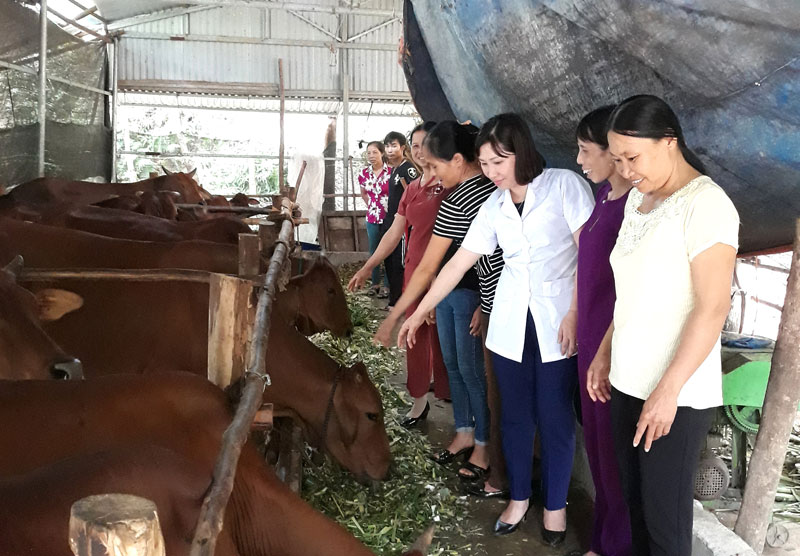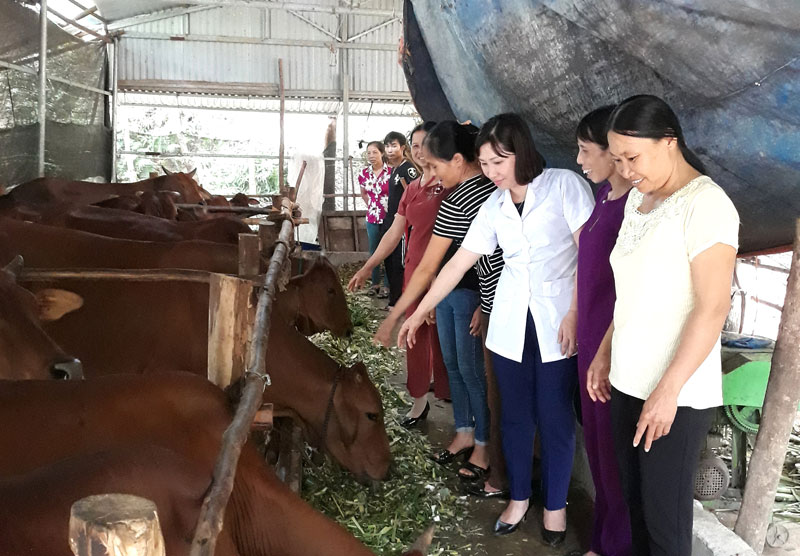
(HBO) – The year of 2018 is an important milestone marking the time of 25 years (1993 - 2018) of the agricultural encouragement system.

In 2018, the Provincial Agricultural Encouragement Center continued to
implement effectively the fattening cow model in My Hoa and Kim Tien communes
(Kim Boi district).
In parallel with the direction of production, the Provincial Agricultural
Encouragement Center has always focused on building models, in 2018, the Center
implemented 9 demonstration models. In which, there are 4 models of
agricultural encouragement with the total cost of over 1,230 million VND,
including: the model of raising fish in cages (200 m3 with 4 participating
households); raising cow to achieve high productivity, quality and efficiency
(with the scale of 205 cows with 70 households involved); raising high quality
honey bees in households (with the scale of 200 litters with 10 participating
households); building and developing the model of synchronous application of
advanced technology in fast growing large timber plantations (36 hectare scale
with 20 households). 5 provincial-level agricultural encouragement models
include: Raising indigenous pigs is implemented in Pa Co commune (Mai Chau
district) with 20 participating households; Improving goat herd in the
direction of meat specialization is implemented in Cao Duong and Tan Thanh
communes (Luong Son district) with 48 households participating; raising
indigenous pigs is carried out in Pu Bin and Noong Luong communes (Mai Chau
district) with 30 households participating; The model of synchronous application
of technical advances in intensive farming of pomelo in the direction of
VietGAP is implemented in Bac Son commune (Kim Boi district) with 10 households
participating; the model of planting and intensifying red pomelo trees is
implemented in Do Nhan commune (Tan Lac district) with 15 households
participating. The total cost of implementing these models is about 729 million
VND.
In addition, the Center cooperates with the Forest Industry Research
Institute (belonging to Vietnam Forestry Science Institute) to develop and
transfer techniques of drying, preserving and processing molds on rattan and
bamboo materials for handicraft villages.
Since the beginning of this year, under the direction of the Department of Agriculture and Environment, the Sub-Department of Agricultural, Forestry, and Fishery Product Quality Management has strengthened the integration of the professional activities to promote and guide the organizations and individuals in the production and trading of agricultural, forestry, and fishery products to comply with the legal regulations regarding the use of chemicals, pesticides and veterinary medicines in crop cultivation, livestock farming and aquaculture. They also provide guidance to processing and manufacturing establishments on keeping the records to trace the product origins and using food additives from the approved list according to the regulations.
Hoa Binh province saw a significant rise in state budget revenue in the first two months of 2025, heard a meeting chaired by Vice Chairman of the provincial People’s Committee Quach Tat Liem.
Ha Thi Ha Chi, a 26-year-old graduate in law, has taken an unconventional path by returning to her hometown in Mai Chau district to establish the Tong Dau Cooperative, creating stable jobs for local women and bringing Thai ethnic brocade weaving to the global market.
As the Lunar New Year 2025 approached, pork prices surged, creating a profitable season for farmers in Tan Vinh commune, Luong Son district. Taking advantage of the rising demand, Can Minh Son, a farmer from Coi hamlet, sold over 30 pigs at 69,000 VND/kg, each weighing more than 100 kg. After deducting expenses, his family earned a profit of over 50 million VND.
alternate member of the Central Party Committee, Secretary of the Hoa Binh provincial Party Committee Nguyen Phi Long on March 5 had a working session with Yan Jiehe, Founder and Chairman of the China Pacific Construction Group, one of China's largest private corporations in the field of transport infrastructure. Deputy Secretary of the provincial Party Committee, Chairman of the provincial People's Committee Bui Duc Hinh and leaders of provincial departments and sectors also attended the working session.
The electronic printed circuit board (PCB) manufacturing and processing plant of Japan’s Meiko Group, located at Da River Left Bank Industrial Park in Hoa Binh city with a total investment of over 200 million USD, is expected to create thousands of jobs and make a significant contribution to the local budget.



